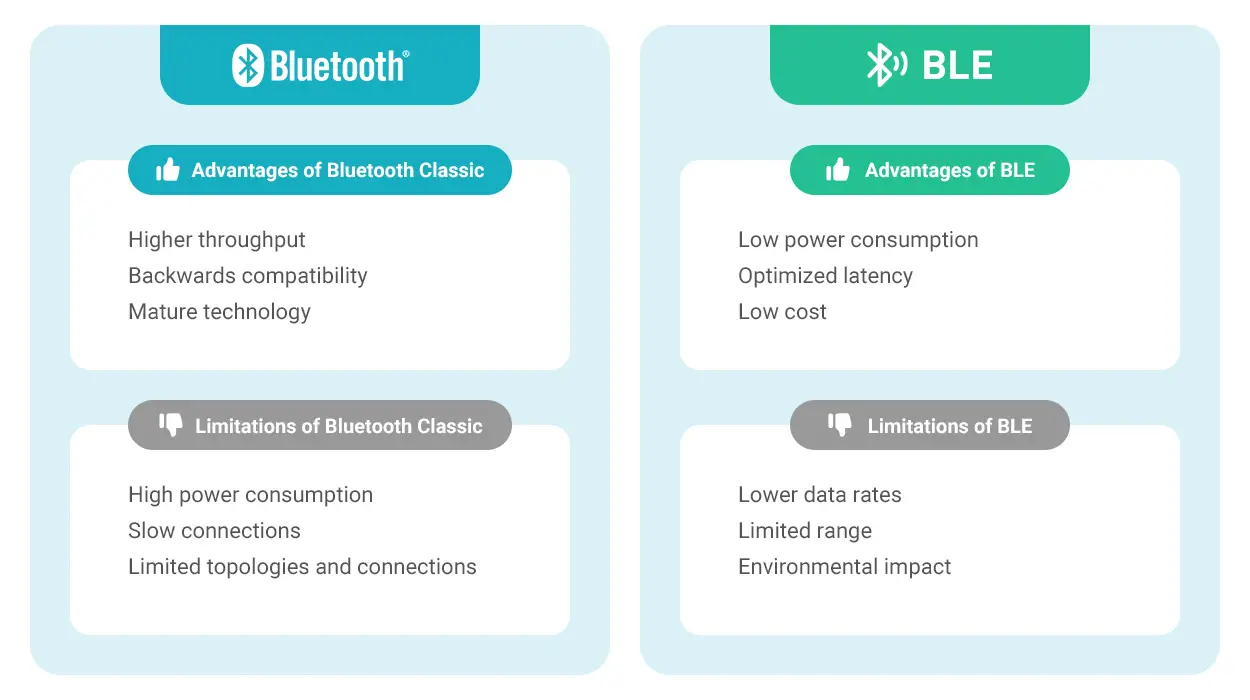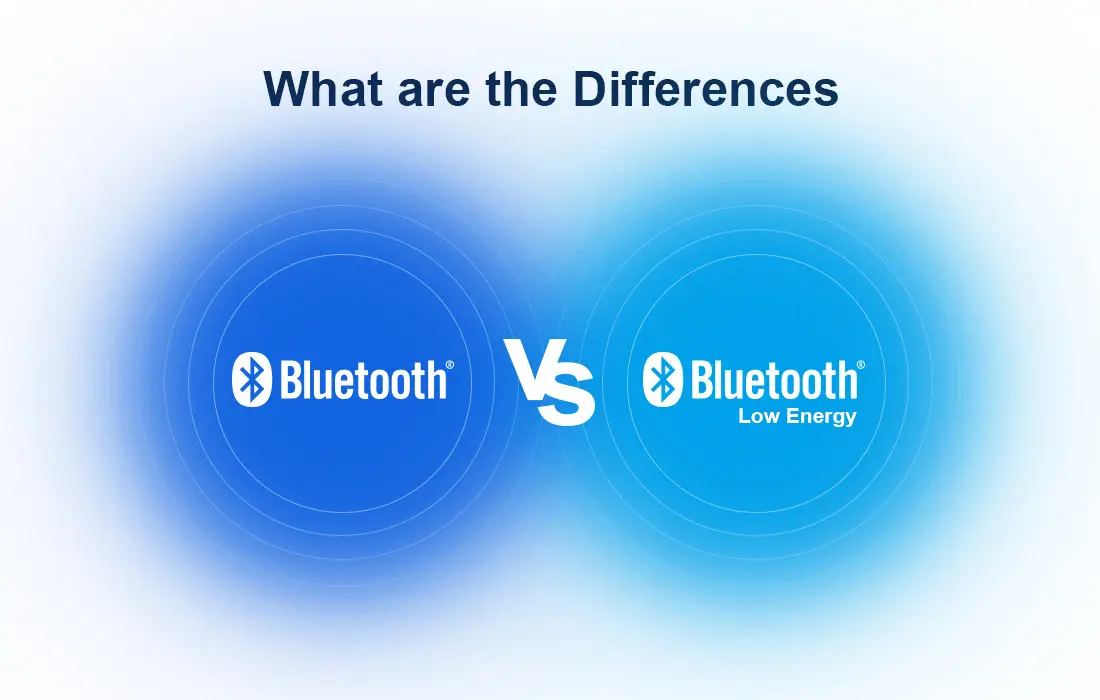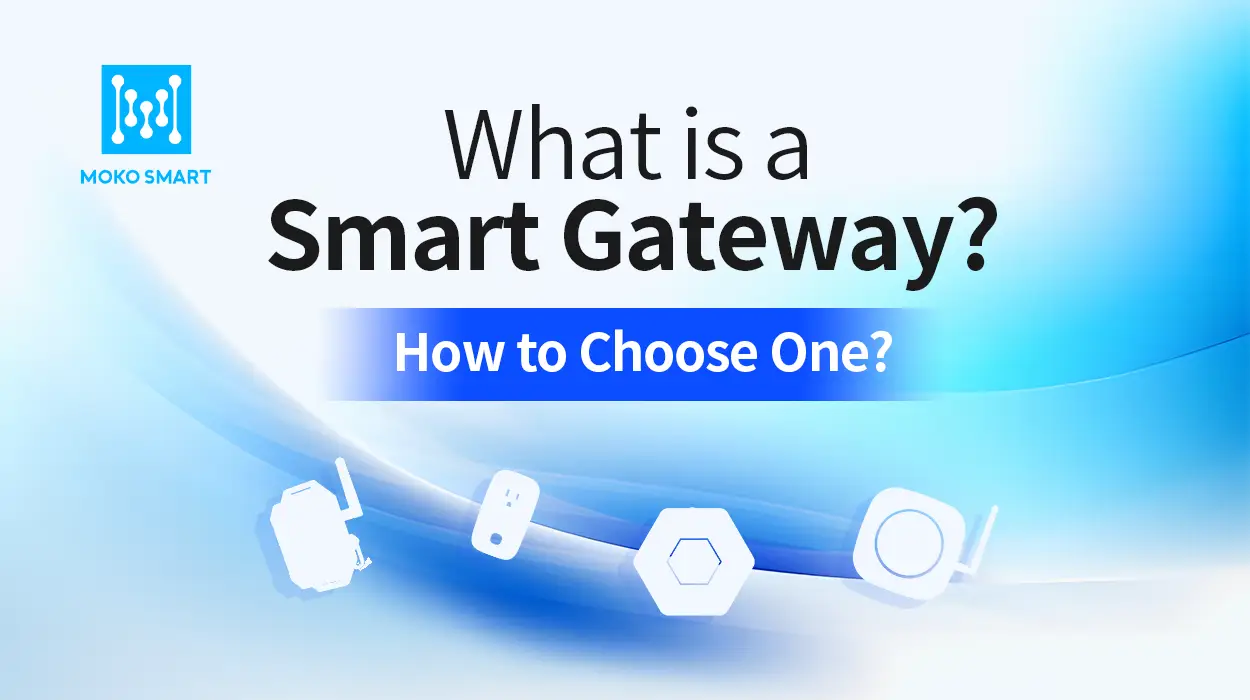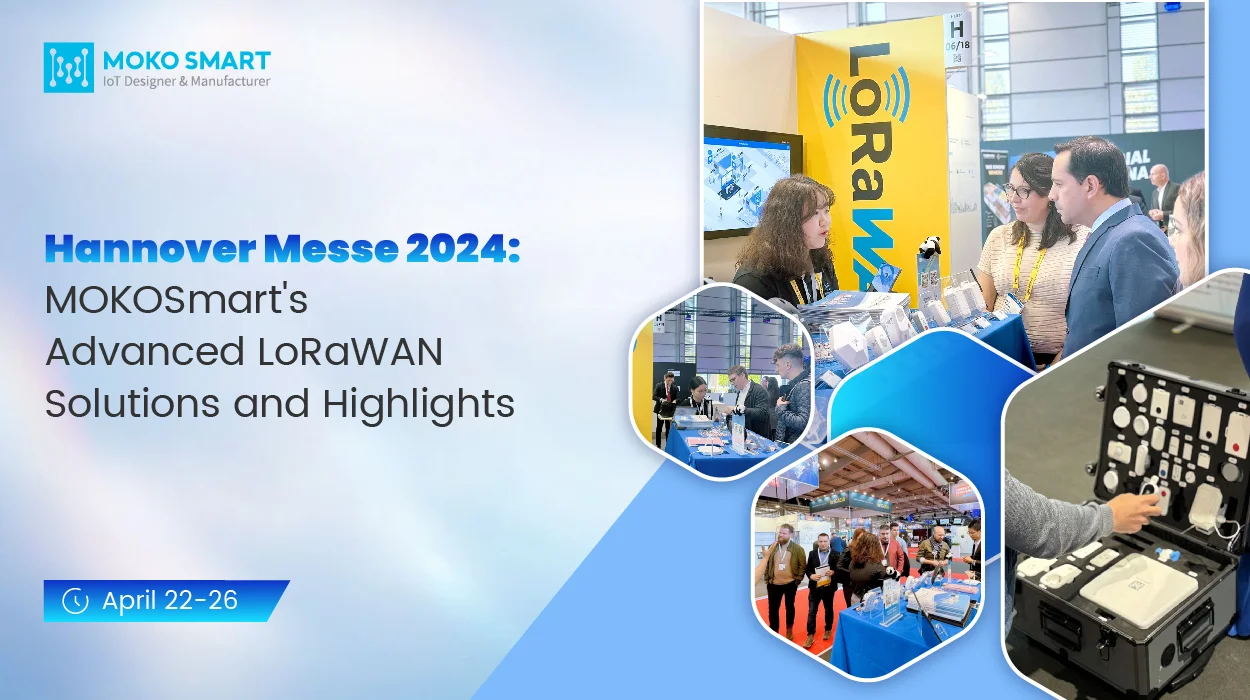Bluetooth, BLE, Bluetooth Classic, Bluetooth Smart…what does it all mean?! With wireless technology, too many similar names make our heads spin like a Beyblade. Maybe Bluetooth should be called BlueTeeth since it helps our devices talk to each other. Suffice to say, back in its inception no one envisioned a future where we have wireless headphones, smart home devices, fitness trackers, and more all connected via Bluetooth. But it did and come a long way with different Bluetooth versions. In this article, we’ll break down some key differences between Classic Bluetooth vs Bluetooth Low Energy (BLE).
An overview of Bluetooth technology
When it comes to the definition of Bluetooth technology, chances are that you know it is a short-range wireless communication standard. However, you may be dazzled since the Bluetooth SIG has released various versions of the Bluetooth specification over the years. Actually, keeping all the different Bluetooth versions straight is about as much fun as untangling old headphone wires. Here’s the basics of Bluetooth vs Bluetooth Low Energy:
What is Classic Bluetooth?
The original incarnation, known today as Classic Bluetooth, is the bedrock of our familiarity with wireless connectivity. Generally, Bluetooth Classic refers to the original Bluetooth technologies – Basic Rate (BR), Enhanced Data Rate (EDR) and Amplify (AMP) – that were available prior to Bluetooth 4.0. Operating over 79 channels in the 2.4 GHz frequency band, it enables devices like phones and headphones to form personal area networks (PANs) to transmit data over short distances.
In fact, Classic Bluetooth isn’t an official term. It is a convenient reference to the original BR/EDR/AMP technology suite, as defined by the Bluetooth SIG, showcasing the technology’s dynamic evolution. Additionally, one of its most notable roles is as the linchpin for audio device pairings with mobile phones. Bluetooth Classic has become important to daily life, particularly as the trend toward smartphone devices without headphone jacks continues. The process of connecting two devices via Classic Bluetooth is now a commonplace skill.
What is Bluetooth Low Energy?
Distinguished as part of the Bluetooth 4.0 core specification, Bluetooth Low Energy (BLE) represents a quantum leap in power efficiency within the Bluetooth ecosystem. Also known as Bluetooth Smart, BLE shares the same management and oversight by Bluetooth SIG. Its defining feature lies in its minimal power consumption and energy-efficient sleep modes. Consequently, this enables BLE devices to operate for extended periods using small coin cell batteries.
BLE operates within the same 2.4 GHz frequency range as standard Bluetooth but employs a distinct frequency-hopping spread spectrum (FHSS) scheme. While BLE shares the same radio spectrum as its predecessor, it operates at approximately half the data rate, offering a balance between power conservation and effective communication range.
In essence, Bluetooth Low Energy is not merely a streamlined version of Bluetooth Classic, but rather a specialized and efficient iteration that caters to a spectrum of applications demanding energy-efficient wireless connectivity.
Classic Bluetooth vs BLE: feature-by-feature comparison
Now that we’ve covered the basics of Bluetooth LE and Bluetooth, let’s directly compare some key technical differences between Classic Bluetooth and Bluetooth Low Energy:
Battery Consumption
While Classic Bluetooth is very power efficient compared to other wireless standards, BLE manages to cut power consumption even further. Where Bluetooth Classic has much higher power demands, Bluetooth Low Energy can run for years on a single coin cell battery. For IoT applications requiring consistent low power, BLE is the clear winner.
Data Transfer Rates
Bluetooth Classic has a superior maximum data rate of around 3 Mbps compared to Bluetooth Low Energy which tops out at around 1 Mbps. However, BLE’s lower rate is sufficient for periodic transfer of small amounts of data, which is a common IoT use case. The higher throughput of Bluetooth Classic comes at the cost of higher power usage.
Latency
Latency refers to the time delay for a data packet to be transmitted successfully. Here Bluetooth Low Energy actually achieves lower latency times of about 6 ms compared to 100 ms for Bluetooth Classic. As a result, BLE can enable much more responsive device communication, which is critical for real-time IoT applications.
Range
Bluetooth 5.0 increased the maximum Bluetooth range considerably up to around 800 feet or 240 meters. In practice though, the typical reliable range remains at about 30 m for Classic Bluetooth, and 50 m for Bluetooth Low Energy. Outdoors with line of sight, BLE optimal range extends to 150 m. Even though Bluetooth 5.0 improved things, range comes down to antenna design and transmission power rather than differences between the core technologies themselves.
Topology
The topology refers to how devices connect and communicate within a network. Bluetooth Classic uses a simple peer-to-peer topology where two devices communicate directly. Bluetooth Low Energy supports peer-to-peer as well as star topology where many devices communicate with a central master device. Furthermore, BLE also provides broadcast from one device to many and Bluetooth mesh networking. The extra topology options in Bluetooth LE give it far more flexible and scalable network architectures suited for IoT implementations.
| Bluetooth Classic | Bluetooth Low Energy | |
| Frequency Band | 2.4 GHZ ISM Band | 2.4 GHZ ISM Band |
| No. of Channels | 79 one MHz Channel | 40 two MHz Channel |
| Power Consumption | Low | Less |
| Data Rate | 1-3 Mbps | 1 Mbps |
| Latency | Approx. 100 ms | Approx. 6 ms |
| Range | < 30 m | 50 m ( 150 m in open area) |
| Topology | Peer-to-peer (1:1) | Peer-to-peer (1:1)
Star (many:1) Broadcast (1:many) Mesh (many:many) |
| Device pairing | Required | Not Required |
| Voice capable | Yes | No |
| Nodes/Active Slaves | 7 | Unlimited |
| Security | 64b/128 bit, user defined application layer | 128 bits AES, user defined application layer |
| Smartphone Compatibility | 100% available on smartphones | 100% available on smartphones |
| Use Cases | Streaming applications like audio streaming, file transfer, and headsets | Location beacons, smart home applications, medical devices, industrial monitoring, fitness trackers |
Pros and Cons of Classic Bluetooth and BLE
As Bluetooth has diversified into standards serving different needs, it is important to understand their respective strengths and limitations. Now let’s summarize some of the key benefits and limitations of Bluetooth LE vs Bluetooth Classic:

Advantages of Bluetooth Classic
- Higher throughput: Bluetooth Classic has a higher data transfer rate of around 3 Mbps, providing quick data transfer of large files like audio streams.
- Backwards compatibility: Bluetooth Classic maintains backwards compatibility with legacy devices, keeping connection to older accessories.
- Mature technology: As the longer-standing standard, Bluetooth Classic benefits from decades of refinement and widespread compatibility.
Limitations of Bluetooth Classic
- High power consumption: Due to its high power demands during transmission and discovery, the battery life of Bluetooth devices drains quickly.
- Slow connections: With a latency of around 100ms, Classic Bluetooth lags for applications needing rapid back-and-forth communication.
- Limited topologies and connections: Classic Bluetooth only gives a simple peer-to-peer topology and limits slave connections to 7 devices.
Advantages of Bluetooth Low Energy
- Low power consumption: Can last for months or years on a tiny battery, ideal for IoT devices.
- Optimized latency: Latency down to 6 ms enables responsive control applications.
- Low cost: The low cost of chipsets and components keep BLE device costs very low.
Limitations of Bluetooth Low Energy
- Lower data rates: Max data rate around 1-2 Mbps, unsuitable for high bandwidth communications, and is much lower than WiFi/cellular.
- Limited range: Typical coverage of under 200m even in line of sight.
- Environmental impact: Performance degraded by obstacles like walls or bodies.
Bluetooth vs Bluetooth Low Energy: different use cases
Bluetooth Classic and Bluetooth Low Energy suit different applications based on their capabilities. As we explored before, Bluetooth Classic is most commonly used in audio devices like wireless headphones and speakers, as well as for file transfer between devices. Indeed, it is intended for direct use by average consumers who can easily buy and utilize those Bluetooth devices.
In contrast, Bluetooth LE is optimized for commercial IoT devices given its efficiency for low power periodic data collection. While also used in personal devices like fitness trackers focused on data collection, BLE is heavily used in healthcare for monitors and industrial settings for location services and condition monitoring. Its low power and high efficiency make BLE ideal for these IoT use cases involving frequent small data transfers.
With the above comparison in mind, here are the different use cases for Classic Bluetooth vs Bluetooth Low Energy:
Common Classic Bluetooth use cases include:
– Streaming music to wireless headphones and speakers
– Connecting wireless keyboards, mice, and printers
– Hands-free calling in cars
– Transferring files between devices
– Providing internet connectivity through tethering
Bluetooth Low Energy is optimized for compact IoT devices collecting small amounts of sensor data. Common BLE use cases include:
– Connecting wearable fitness trackers that monitor steps, heart rate, etc.
– Smart home sensors for temperature, motion, etc.
– Location beacons to provide proximity-based services
– Industrial IoT sensor networks for condition monitoring
– Healthcare devices like glucose monitors that need low power
– Public transportation apps that detect nearby buses/trains
What’s next for Bluetooth
The most recent major Bluetooth update was Bluetooth 5.0 released in 2016, which improved speed/range tradeoffs for Bluetooth Low Energy devices. More recently in 2022, the Bluetooth SIG announced a new Bluetooth audio broadcast capability called Auracast that will enable new multi-listener consumer audio applications by transmitting audio to unlimited nearby Bluetooth receivers.
Looking ahead, the next major iteration Bluetooth 6.0 could arrive within the next few years based on typical release cycles. Bluetooth SIG has not made any official announcements about v6.0 yet, but it will likely continue improving power efficiency, range, and speeds to expand possibilities for IoT and audio applications. With the internet-of-things and wireless earbuds both seeing rapid growth, demand for low-power and robust wireless technology continues rising. The Bluetooth SIG will aim to meet these needs with the next generation while maintaining backwards compatibility.
Overall, if you’re working with Bluetooth Low Energy technology, MOKOSmart can help provide a series of BLE beacons and sensors for various applications to create the best possible user experience.
CONTINUE READING ABOUT BLUETOOTH
























